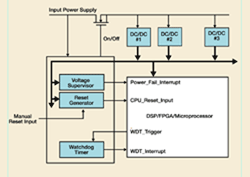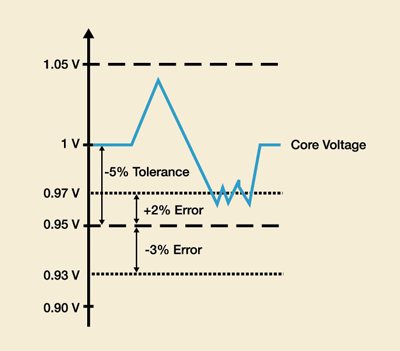Programmable power circuits improve reliability, cut cost
A higher level of integration helps reduce system cost and virtually eliminates reliability concerns
BY TROY SCOTT
Lattice Semiconductor
Hillsboro, OR
http://www.latticesemi.com
System engineers are pressured to cut costs and improve the reliability of circuit boards. An often overlooked opportunity to do this is to reduce the number of components used for FPGA, microprocessor and DSP power monitoring.
New highly integrated and programmable power circuits combine reset generation, watchdog timer (WDT), and voltage supervisor ICs into a single device. This higher level of integration helps reduce system cost and virtually eliminates reliability concerns.
Challenges
In the case of a typical DSP, FPGA, or microprocessor, a variety of supply voltages are required: for example, 1.2 V for the device core, 3.3 V for auxiliary and PLL supplies, and 1.5 V and 1.8 V for I/O driver supplies.
A common design implementation is to provide the various power supplies through a series of dc/dc converters operating from a single 5-V input power supply. To provide the same level of reliability as a simple single-supply pc board, all of the supplies on the board must be monitored to produce the correct CPU reset or power failure interrupts.
The voltage supervisor block in Fig. 1 is an IC that notifies the CPU of a power failure condition or when the board is powered down manually. If any one of the dc/dc converters fails, a voltage level may drop or increase outside the range of legal operation, which can lead to incorrect program execution by the CPU.
One potential worst-case scenario is for the CPU to overwrite nonvolatile memory and render the system unbootable. If the CPU can be interrupted upon power failure, it may be able to conduct housekeeping to safely abort current activity and save the critical information required for a reliable restart.

Fig. 1. A typical power circuit requires a variety of supply voltages.
An often overlooked side effect of many inexpensive voltage supervisor ICs is how the supervisor threshold will impact the overall system’s tolerance for voltage variation. For example, in Fig. 2 , the core voltage specification is 1 V ±5%. With this requirement, the supervisor must issue an interrupt signal if the CPU core falls below 0.95 V.
However, when the supervisor threshold accuracy is accounted for, the overall tolerance for voltage variations is lowered. In the example, the supervisor threshold is 0.95 V 2%/3% (0.97 to 0.93 V). Using this supervisor IC, the threshold should be set to 0.97 V, which restricts the dc/dc converter tolerance.

Fig. 2. Shown is a comparison of core specification and supervisor threshold.
The reset generator block in Fig. 1 is another common discrete IC used to release the CPU reset input after all voltage supplies stabilize. It’s common for a CPU to be held in the reset mode for an extended period of time after all supplies are stable. For example, the Mobile Intel Atom Processor expects a “pulse-stretched” 2-ms reset pulse after the power-good input signal is asserted. Only then will the CPU begin program execution.
The final discrete IC is the watchdog timer block in Fig. 1 . This timing device triggers a system reset if the main program fails to regularly service the watchdog. The intent is to bring the system back from a hung state into normal operation.
Improved economy, flexibility
The wide variety of power, reset, and WDT application scenarios have led component suppliers to field a staggering array of discrete digital and mixed-signal components designed to help address the power management challenge. Discrete voltage supervisor, reset, and timer circuits, however, contribute to layout complexity and the cost of a PCB.
Since voltage fluctuation is a normal supply line characteristic due to board-level parasitics and switching power supplies, one cost-cutting measure employed by designers is to use less-accurate, less-expensive voltage supervisor devices. However, cheap supervisor thresholds that vary over 1% will lower the system’s tolerance for power ripple in supply lines and lead to reset conditions more often than necessary.
Another cost-cutting measure in some designs is not to monitor all supply rails in the hope that dc/dc converters will never fail during normal operation. This is another example where reliability is compromised to reduce cost.
Board variations often force a redesign of power management circuits using a different component mix each time. The use of inflexible discrete ICs forces redesigns more often, means more components to qualify, and inflates inventory levels.
The shortcomings inherent in many power management circuit designs have led to the idea of merging a complex reprogrammable PLD with precision analog circuits in the same device. A PLD would provide the flexibility for a variety of logic sequences with a state-machine or Boolean logic description.
Improved threshold monitors with very accurate programmable trip points would allow the same IC to be used in a wider variety of supply monitoring applications. In short, a programmable power management IC could help designers standardize on a more universal power management solution.
An example
Current power management ICs are designed to integrate and improve the accuracy of many board-level supervisory ICs. These devices merge precision fault-monitoring circuits, a CPLD and ADC/DAC circuits on the same device.
For example, Lattice Semiconductor’s Power Manager II products can monitor up to six power supplies and provide seven digital outputs. The device can generate signals such as a CPU reset, including pulse stretching and power supply fault interrupt, using the PLD block with four programmable timers.
Two of the seven outputs can be configured as high-voltage MOSFET drivers, and five of the seven outputs can be configured as inputs. There are also two general-purpose digital inputs, which can be used for other control functions.
Such an integrated power management IC replaces all three voltage supervisor, reset generator, and WDT power management ICs described earlier, and at a lower cost. In some cases, even replacing just two discrete ICs can result in a more economical design. The power management IC’s integration helps save time and money, and can be used across multiple designs.
The six voltage monitors (VMON) of the Power Manager II POWR607 device are independently programmable. A trip-point comparator provides 192 programmable points over a range of 0.667 to 5.811 V.
Each provides a 75-mV zero-detect option to determine if a supply’s output has decayed to an inactive condition after it has been switched off. Each comparator outputs a logic level high to the PLD block if the monitored voltage is greater than the trip-point setting.
A hysteresis of approximately 1% of the setpoint is provided by the comparators to reduce false triggering as a result of input noise induced by the PCB and normal power ripple due to switching power supplies. Both over and under voltage trip points are programmable to reflect the tolerance of the DSP/FPGA/microprocessor being managed.
Each voltage monitor provides a digital filter than can be enabled to delay the comparator output to avoid false trigger conditions. WDT functions for the CPU are provided by a built-in oscillator and programmable timer circuit that can issue sequences in intervals from 32 μs to 2 s.
Today’s devices have proven attractive to digitally oriented system engineers as well as analog power supply designers by providing a simple software programming interface. A schematic block diagram allows the designer to configure the analog blocks with dialog boxes and an equation builder makes construction of reset sequences easy.
The device provides an in-system programming (ISP) JTAG interface and access to the standard JEDEC file format. The ISP interface allows for changes or upgrades while the device is on-board, and helps provide better visibility than traditional discrete IC though the JTAG chain.
The reprogrammable power manager concept helps speed changes to existing boards and ease modifications for new designs. By integrating the discrete ICs found in most power management applications, programmable power manager ICs provide better flexibility and lower bill-of-material costs. ■
For more on programmable power circuits, visit http://www2.electronicproducts.com/AnalogMixICs.aspx.
Advertisement
Learn more about Lattice Semiconductor





